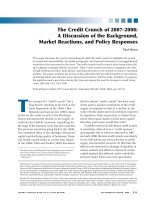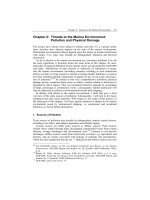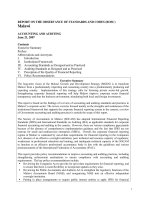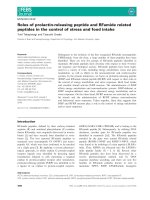Chapter 4 - Exploring the External Environment: Macro and Industry Dynamics potx
Bạn đang xem bản rút gọn của tài liệu. Xem và tải ngay bản đầy đủ của tài liệu tại đây (627.66 KB, 23 trang )
Chapter 4
Exploring the External Environment:
Macro and Industry Dynamics
2
OBJECTIVES
Explain the importance of the external context for
strategy and firm performance
1
Use PESTEL to identify the macro characteristics of
the external context
2
Identify the major features of an industry and the
forces that affect industry profitability
3
Understand the dynamic characteristics of the
external context
4
Show how industry dynamics may redefine
industries
5
Use scenario planning to predict the future structure
of the external context
6
3
THE COLA WARS (TIMELINE)
Coca-Cola
Coca-Cola invented
“Kick Pepsi's can”
Diet Coke
New Coke
Repair Coke and restore
Stock price
Diversify product line
188
6
195
0
196
0
197
0
198
0
199
0
2000
Pepsi
“Beat Coke”
“Pepsi Generation”
“Pepsi Challenge”
Foster entrepreneurial
spirit of Pepsi’s people
Jettison slow-growing
businesses
Diversify beyond
soft-drinks
4
EXTERNAL CONTEXT OF STRATEGY
•
An internal analysis is
just half of what is
needed to build
strategy
•
The SWOT and more
complicated
frameworks help us
understand the full
picture
Internal
•
Strengths
•
Weaknesses
•
Capabilities
•
Relationships
•
Etc.
5
BLURRING OF INDUSTRY BOUNDARIES
With fewer
companies providing
these services, the
power of buyers will
be impacted.
As services are
bundled, the cost to
switch to another
service provider will
be greater.
Cable
Companies
Long Distance
Telephone
Companies
Internet
Provider
Companies
6
THE BALANCE OF POWER
Wal-Mart
Rubbermaid
7
THE EXTERNAL ENVIRONMENT OF THE ORGANIZATION
Macro Environment
Political, Economic, Sociocultural,
Technological, Environmental, Legal
Industry Environment
Strategic Group
The Organization
8
KEY QUESTION TO ASK
What macro environmental
conditions will have a material
effect on our ability to implement
our strategy successfully?
How stable are these
characteristics?
What is our
firm’s industry?
What are the
characteristics of the
industry?
9
PRESSURES FAVORING INDUSTRY GLOBALIZATION
•
Interdependent
countries
•
Homogeneous
customer needs
•
Favorable trade
policies
•
Large scale and
scope economies
•
Global
competitors
•
Global customer
needs
•
Common
technological
standards
•
Learning and
experience
•
Global channels
•
Common
manufacturing
and marketing
regulations
•
Sourcing
efficiencies
CompetitionMarkets GovernmentsCosts
•
Favorable
logistics
•
Arbitrage
opportunities
•
High R&D costs
•
Transferable
marketing
approaches
Source: Adapted from M.E. Porter, Competition in Global industries (Boston: Harvard Business School Press,
1986); G. Yip, “Global Strategy in a World of Nations, “ Sloan Management review 31:1 (1989), 29-40
10
KEY SUCCESS FACTORS AS BARRIERS TO ENTRY
Key asset or requisite skill
that all firms in an industry
must possess in order to be
a viable competitor
Key success factor (KSF)
Ability to meet competitive pricing
Extensive distribution
Ability to raise consumer awareness
Broad product mix
Global presence
Well positioned bottlers and bottling
capacity
KSFs:
SOFT DRINK EXAMPLE
11
INDUSTRY FRAGMENTATION AND CONCENTRATION
Monopoly Duopoly Fragmented
12
ENVIRONMENTAL TRENDS
Silent
Generation
Silent
Generation
–
Born between 1932 and 1945
Baby Boomers
Baby Boomers
–
Born between 1946 and 1964
Generation X
Generation X
–
Born between 1965 and 1977
Generation Y
Generation Y
Born between 1978 and 1994
13
ANALYZING INDUSTRY STRUCTURE USING FIVE – FORCES
Buyer Power (Channel and End consumer)
•
Bargaining leverage
•
Buyer volume
•
Buyer information
•
Brand identity
•
Price sensitivity
•
Threat of backward integration
•
Product differentiation
•
Buyer concentration vs. industry
•
Substitutes available
•
Buyer’s incentives
Supplier Power
•
Supplier concentration
•
Importance of volume to supplier
•
Differentiation of inputs
•
Impact of inputs on cost or differentiation
•
Switching costs of firms in the industry
•
Presence of substitute inputs
•
Threat of forward integration
•
Cost relative to total purchases in industry
Threat of New Entrants (and Entry Barriers)
•
Absolute cost advantages
•
Proprietary learning curve
•
Access to inputs
•
Government policy
•
Economies of scale
•
Capital requirements
•
Brand identity
•
Switching costs
•
Access to distribution
•
Expected retaliation
•
Proprietary products
Threat of Substitutes
•
Switching costs
•
Buyer inclination to substitute
•
Price-performance tradeoff of
substitutes
•
Varity of substitutes
•
Necessity of product or service
Degree of Rivalry
•
Exit barriers
•
Industry concentration
•
Fixed costs/value added
•
Industry growth
•
Intermittent overcapacity
•
Product differences
•
Switching costs
•
Brand identity
•
Diversity of rivals
•
Corporate stakes
Source: Adapted from M.E. Porter, Competitive Strategy: Techniques for Analyzing Industries and Competitors (New York: Free Press,
1980)
Industry value chain –
from raw materials and
other inputs, to channel
to end consumer
Complementors
Number of complements
Relative value added
Barriers to complement
entry
Difficulty of engaging
complements
Buyer perception of
complements
Complement exclusivity
14
CAUSES OF RIVARLY
Barriers to Entry
•
Strong brands
•
Proprietary technology
•
Start-up costs
•
Etc.,
Barriers to Exit
•
Few other opportunities
•
Sunk investments
•
Etc.,
In addition to entry
and exit barriers,
many factors drive
rivalry
•
History of price wars
•
Level of fixed costs
•
Industry
concentration
•
Market growth
•
Etc.
15
SUPPLIER POWER
When firms in the supply
industry can dictate
terms, they can extract
greater profits
Diamond supply
Percent
DeBeers
Others
50
Diamond
Retailers
50
16
BUYER POWER
Suppliers Buyers
Profits
ILLUSTRATIVE
In industries
characterized with
many suppliers
and few buyers,
buyers often
capture a greater
share of profits
Industry A
Suppliers Buyers
Industry B
Profits
17
THREAT OF SUBSTITUTES
Soft drinks
Coke Pepsi
Movie rentals
Block buster
Hollywood video
Bottled water
Cable TV
18
IMPACT OF COMPLEMENTOR
Any factor that makes it more
attractive for suppliers to supply an
industry on favorable terms or that
makes it more attractive for buyers to
purchase products or services from an
industry at prices higher than it would
pay absent the complementor
Complementor:
Hot dogs
+
Buns
More sales
Three Examples
Music
+
MPS player
More attractive offering
Delta plane
orders
+
American
Airlines
plane orders
Lower costs from Boeing
19
INDUSTRY LIFE CYCLE
Source: Adapted from K. Rangan and G. Bowman, “Beating the Commodity Magnet,” Industrial Marketing Management 21 (1992), 215-224; P. Kotler,
“Managing Products through their Product Life Cycle,” in Marketing Management: Planning, Implementation, and Control, 7
th
ed (Upper Saddle River, NJ:
Prentice Hall, 1991)
Market Size
Time
Embryonic
Technological
uncertainty
Niche market –
selected products for
selected markets
Participants
emphasize problem
solving – product as
“solution”
Growing
Customers become
better informed
Market expands
beyond niche
More competitors
enter
Mature
Aggressive
customers
Proliferation of
products and
markets served
Market volatility and
beginnings of
industry
consolidation
In Decline
Product/market
contraction
Further consolidation
and industry
regeneration
20
COMPETITIVE INTELLIGENCE
Competitive intelligence is
a method whereby firms
are able to gather
information about their
competitors.
21
TECHNOLOGICAL DISCONTINUITIES
Discontinuities
Process-related
Product-related
Southwest airlines
radically changed the
airline business model
by adopting new
processes (e.g., a
point-to-point model)
In disk-drive industry,
virtually every new
generation of
technology led to
demise of market leader
Example
22
SCENARIO PLANNING
Assess the strategic
implications of each
scenario
6
Specify indicators that can signal which
scenario is unfolding
5
Flesh out the picture4
Develop the framework by defining two specific axes3
Brainstorm key drivers, decision factors, and possible scenario departure
or divergence points
2
Define target issue, time frame, and scope for scenarios1
An understanding of the big picture
and a plan to manage uncertainty
23
HYPERCOMPETITION
“Market stability is threatened by
short product life cycles, short
product design cycles, new
technologies, frequent entry by
unexpected outsiders,
repositioning by incumbents, and
tactical redefinitions of market
boundaries as diverse industries
emerge.”
– Richard D’Aveni









